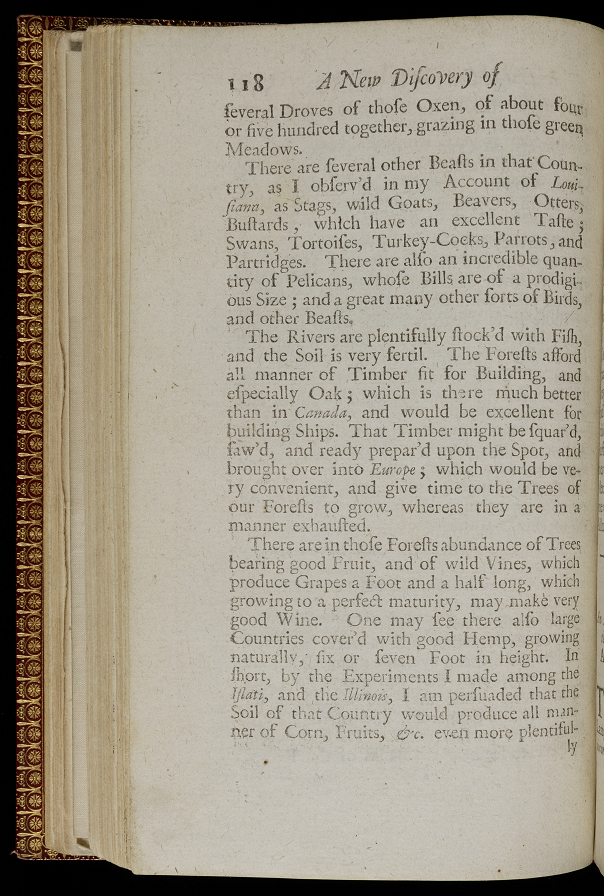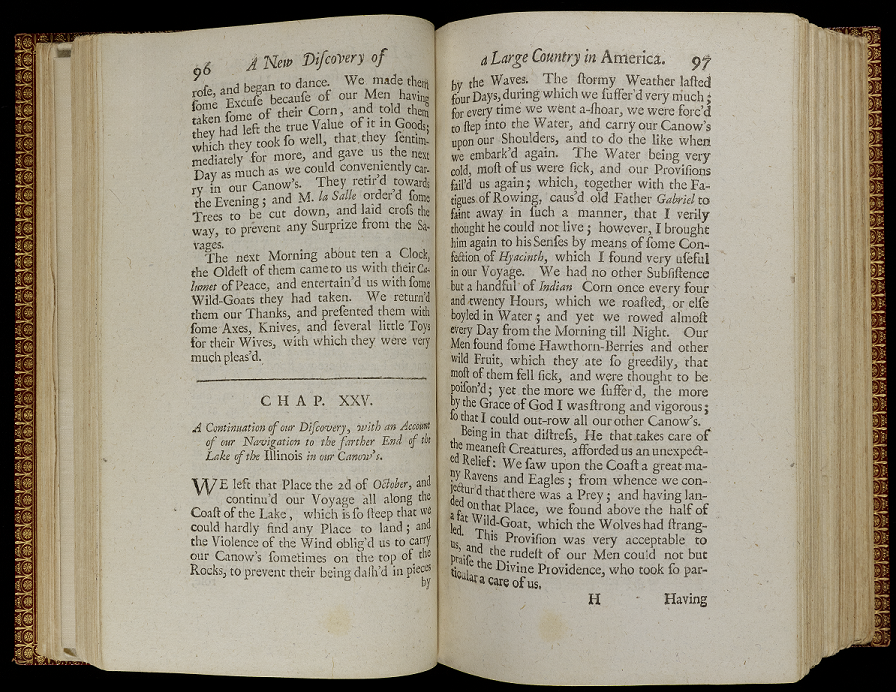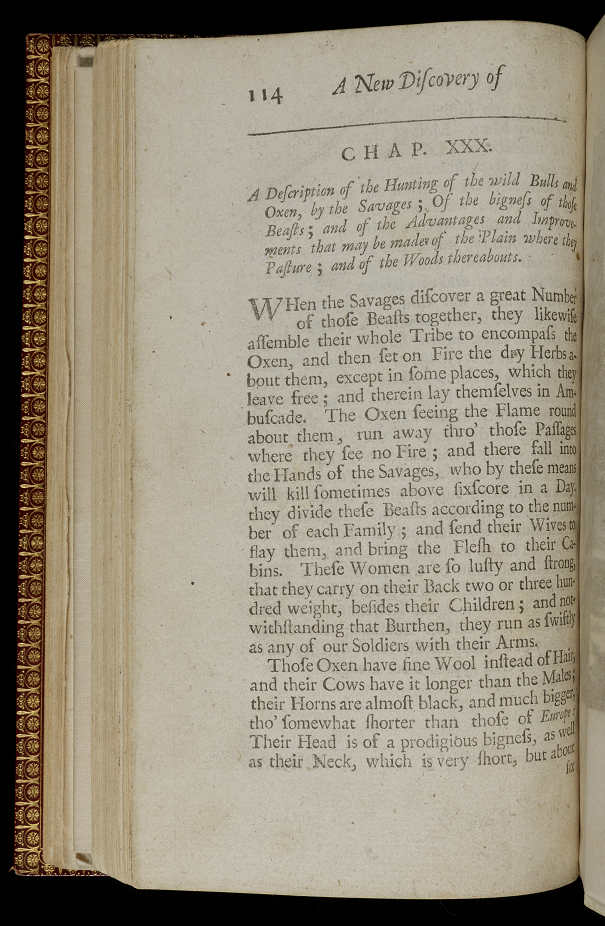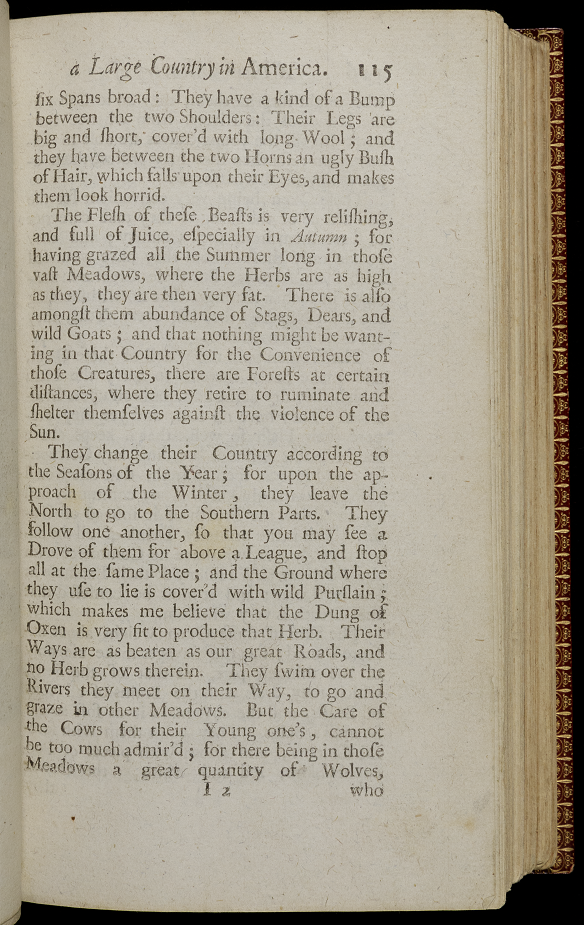Themes
Colonization
Conquest
Environmental History
Exploration
Illinois History
Periods
17th – 18th Centuries
Early American History
Skills & Document Types
Close Reading
Materials — Available for Download in the Downloads Tab
- A copy of the activity “Early European Travel in Illinois”
- A copy of the sources used in this lesson, both original images (high-resolution versions online) and transcriptions
- Student worksheet
Process
You and your students will examine three excerpts from Louis Hennepin’s A new discovery of a vast country in America (1698) from the Newberry Library’s Special Collections. You will guide the students, either as a class or in small groups, through a list of discussion questions about each source.
First, give students some brief background information about the source. (See Background section below.) Read the excerpt that describes bison to the students. Ask students to try to figure out what animal is being described (Excerpt 1). You can provide students with paper and markers and have them try to draw the animal and then ask them what they think it is, or you can have them follow along with your descriptions and guess along the way. After the animal is identified as a bison, ask the corresponding questions.
Then, read Excerpt 2 about other animals and the landscape, and ask those corresponding questions. Finally, read Excerpt 3, about how Hennepin’s group travelled through the Great Lakes, and discuss those questions with students. An extension activity uses Excerpt 4, a description of an Illini village, to prompt students to think about how text can work as a kind of map.
You could also split the class into small groups and assign Experts 2 and 3 (and even 4) to the groups for discussion. The groups can share out or be recombined so that students teach each other about the source analyzed by their group.
Materials – Available in the Downloads tab
- Copies of excerpts from Louis Hennepin’s A new discovery of a vast country in America (also available online)
- If desired: Student handout
Excerpt 1: Description of Bison
Their Horns are almost black, and much bigger tho’ somewhat shorter than those of Europe. Their Head is of a prodigious bigness, as well as their neck, which is very short, but about six [hand] Spans broad: They have a kind of a Bump between the two Shoulders: Their Legs are big and short, cover’d with long Wool; and they have between the two Horns an ugly Bush of Hair, which falls upon their Eyes, and makes them look horrid.
Hennepin, A new discovery of a vast country in America, 114-115 (1698)
Questions:
- What animal is being described?
[After students conclude, or learn, that the animal is a bison.]
- Do bison live in Illinois now? Where are they/why are they not here anymore?
- Why does Hennepin describe the animal this way? What do you think this animal would sound like to his readers, who never saw a bison?
Excerpt 2: Animals and Landscape

There are several other Beasts in that Country… Stags, wild Goats, Beavers, Otters, Bustards, which have an excellent Taste; Swans, Tortoises, [Turkeys], Parrots, and Partridges. There are also an incredible quantity of Pelicans, whose Bills are of a prodigious Size; and a great many other sorts of Birds, and other Beasts.
The Rivers are plentifully stock’d with Fish, and the Soil is very fertile. The Forests afford all manner of Timber fit for Building, and especially Oak; which is there much better than in Canada, and would be excellent for building Ships. That Timber might be squar’d, saw’d, and ready prepar’d upon the Spot, and brought over into Europe; which would be very convenient, and give time to the Trees of our Forests to grow, whereas they are in a manner exhausted.
There are in those Forests abundance of Trees bearing good Fruit and of wild Vines, which produce Grapes a Foot and a half long, which growing to a perfect maturity, may make very good Wine. One may see there also large Countries cover’d with good Hemp, growing naturally, six or seven Foot in height. In short, by the Experiments I made among the Iflati, and the Illinois, I am persuaded that the Soil of that Country would produce all manner of Corn, Fruits, & even more plentifully than in any part of Europe, seeing there are two Crops every Year.
The Air is very temperate, clear, and open, and the Country water’d with several Lakes, Brooks, and Rivers, which are for the most part navigable. The Gnats and other little Flies that are so troublesome in Canada, and some other dangerous Beasts, are unknown in this Country; which in two Years time might supply its Inhabitants, if cultivated, with all things necessary for Life, without wanting anything from Europe…
Hennepin, A new discovery of a vast country in America, 118-119 (1698)
Questions:
- How does Hennepin describe the natural environment of Illinois? What are some words he uses?
- What types of plants and animals are native to Illinois? Is anything missing from Hennepin’s list that surprised you?
- Does Hennepin seem to think the land is a good place for Europeans to try to colonize? What lines from the text make you think that?
- What might a European reading this conclude about the land and environment? Do you think this account would make them want to settle there?
Excerpt 3: Lake Voyage

We left that Place the 2d of October, and continu’d our Voyage all along the Coast of the Lake, which is so steep that we could hardly find any Place to land; and the Violence of the Wind oblig’d us to carry our [Canoes] sometimes on the top of the Rocks, to prevent their being dash’d in pieces by the Waves. The stormy Weather lasted four Days, during which we suffer’d very much; for every time we went a’shoar, we were forc’d to step into the Water, and carry our [Canoes] upon our Shoulders, and to do the like when we embark’d again. The Water being very cold, most of us were sick, and our Provisions fail’d us again; which, together with the Fatigues of Rowing, caus’d old Father Gabriel to faint away in such a manner, that I verily thought he could not live; however, I brought him again to his Senses by means of some Confection of Hyacinth, which I found very useful in our Voyage. We had no other Subsistence but a handful of Indian Corn once every four and twenty Hours, which we roasted, or else boyled in Water; and yet we rowed almost every Day from Morning till Night. Our Men found some Hawthorn-Berries and other wild Fruit, which they ate so greedily, that most of them fell sick, and were thought to be poison’d; yet the more we suffered, the more by the Grace of God I was strong and vigorous; so that I could out-row all our [Canoes].
Louis Hennepin, A New Discovery of a Vast Country in America, 96-97 (1698)
Questions:
- How are Hennepin and his companions traveling? What method of transportation do they use?
- What is their travel experience like? List the hardships they experience on their journey.
- How does Hennepin talk about food in this excerpt? How is this description different from Hennepin’s description of food in Excerpt 2? What do you think caused these differences?
- What does the group survive on? What kinds of foods did they eat? How did they survive?
- What happened to Father Gabriel? Why do you think this happened to him? How did Hennepin help him?
- Why do you think Hennepin included this story in his account?
Background
Louis Hennepin (1678-1680) was a Belgian Catholic missionary and explorer. Sent to Quebec City in 1675 to spread Christianity amongst Indigenous peoples in New France, he struck up a friendship with the explorer Robert Cavelier de La Salle and joined his expedition. He traveled extensively throughout what is now called the United States, including what is now Illinois. On his travels, Hennepin experienced both positive and negative interactions with different Indigenous societies, hunger and hardship, and interpersonal conflicts with his traveling companions. Once returned to Europe, Hennepin published several works based on his travels, including Nouvelle Découverte d’un très grand Pays Situé dans l’Amérique (which translates to A New Discovery of a Vast Country in America).
Extension Activity
Read this fourth excerpt about an Illini village and discuss how Hennepin’s descriptions represent a type of map. Have students work in pairs to draw a map of an Illini village based on Hennepin’s writing, labeling the things that they think are significant to Illini ways of life.
Excerpt 4: The Illini
This Word Illinois comes, as it has been already observ’d from Illini, which in the Language of that Nation signifies A perfect and accomplish’d Man. The Villages of the Illinois are situated in a Marshy Plain, about the fortieth Degree of Latitude, on the Right side of the River, which is as broad as the Meuse [a river in Europe]. Their greatest Village may have in it four or five hundred Cabins, every Cabin five or six Fires, and each Fire one or two Families, who live together in great Concord. Their Cabins are cover’d with Mats of flat Rushes so closely sew’d together, that no Wind, Rain, or Snow may go thro’ it.
When the [Illini] have gather’d in their Indian Corn, they dig some Holes in the Ground, where they keep it for Summer-time, because Meat does not keep in hot Weather; whereas they have very little occasion for it in Winter; and ‘tis then their Custom to leave their Villages, and with their whole Families, to go a hunting Oxen, Beavers, & carrying with them but a final quantity of their Corn, which however they value so much, that the most sensible Wrong one may do them in their Opinion, is to take some of their Corn in their absence. We found nobody in the Village, as we had foreseen; for the Illinois had divided themselves according to their Custom, and were gone a hunting. Their Absence caus’d a great Perplexity amongst us; for we wanted Provisions, and yet durst not meddle with the Indian Corn the Savages had laid under Ground for their Subsistence, and to sow their Lands. However, our Necessity being very great, and is being impossible to continue our Voyage, without any Provisions, especially seeing the Oxen and other Beasts had been driven from the Banks of the River, by means of Fire, as I have related in my former Chapter, M. la Salle resolv’d to take about forty Bushels of Corn, in hopes to appease the [Illini] with some Presents.
Louis Hennepin, A New Discovery of a Vast Country in America, 119-121 (1698)
Questions:
- Ask students about their maps, what they included, what they labeled as important, and why.
- How do the Illini people store their corn? What can we conclude about the Illini relationship with corn?
- Where was everyone from the village when Hennepin arrived?
- According to Hennepin, what is the greatest wrong a person could do against the Illini?
- When the hungry explorers arrive in the village, how do they appease their hunger? What did they do?
- What does this source tell us about Illini ways of life? (Potential answers: They are both farmers and hunters; they move their homes throughout the year/they are semi-nomadic; their main village is large, so they probably have a good-sized population; they are talented craftsmen (their homes are roofed so well that no weather can get in); they live in communal homes and large family groups; they had an important system for storing food and sees for spring (this is important, because taking food from supply was one of the worst ways you could wrong them.)
- What potential sources of conflict between Europeans and Indigenous peoples do you see in this source? Do any of these remind you of anything you already know about interactions between Europeans and Indigenous peoples?
About the Author
Danielle Alesi is an Assistant Professor of History at Millikin University in Decatur, Illinois. She teaches classes on Renaissance and Early Modern, Atlantic World, and Environmental History and conducts research on colonization, animals, and food in the early modern Atlantic World. Danielle previously worked on maps at the Newberry Library as a fellow in the 2022 National Endowment for the Humanities Summer Institute Mapping the Early Modern World.
Download the following materials below:
- A copy of the activity “Early European Travel in Illinois”
- A copy of the sources used in this lesson, both original images (high-resolution versions online) and transcriptions
- Student worksheet
Related Newberry Resources

A custom curriculum hosted by the Newberry and centered on Chicago as a Native Place.
Created in alignment with Illinois State Standards and to support the HB1633 mandate to teach Native history.







